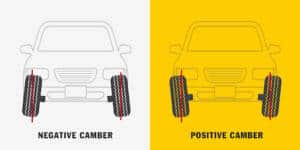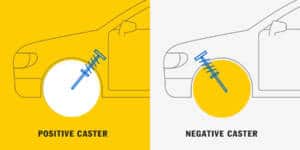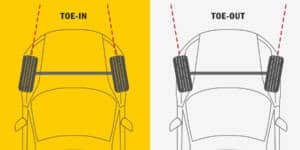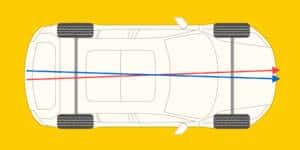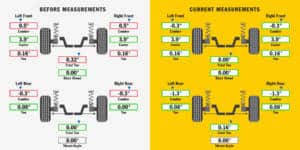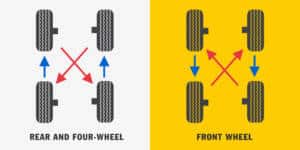How Much Does a Tire Rotation and Alignment Cost?
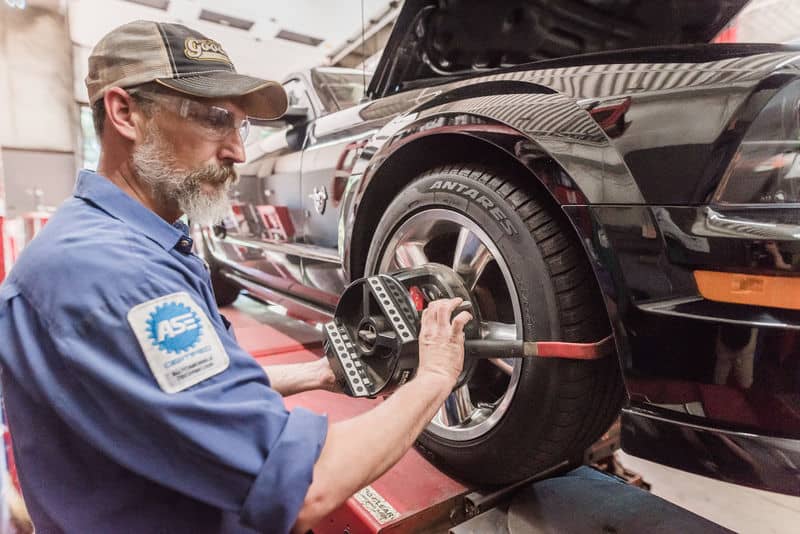
Of all the maintenance your vehicle requires, tire rotation and alignment may not seem as important as oil changes or brake pad replacements, but they have a major impact on how your car drives, handles and operates over time.
Even if you have a short and straightforward commute, the everyday wear will slowly push your wheels out of alignment. And if you’re hitting the potholes and bumps brought on by New England’s changing seasons, you may have some serious alignment issues.
You may assume that you can save time and money by skipping a tire rotation or alignment, but lingering issues will lower your gas mileage (MPG), make it more difficult to drive your car and cause your tires to wear out even faster. Having tires with different levels of wear can increase your risk of a flat tire or even a blowout.
Here’s why tire alignments and rotations are worth the cost and what you can expect to pay.
What is wheel alignment?
What’s involved with an alignment?
Why tires need to be rotated
Average costs
How to tell if you need an alignment or tire rotation
FAQs
What is wheel alignment?
Wheel alignment is the process of making sure all four vehicle wheels point in the same direction, are angled correctly and are in a balanced, square position. Proper alignment allows your vehicle to run safely and more efficiently, which means you’ll experience the following benefits:
- You’ll drive straighter. Properly aligned tires ensure that your vehicle drives straight when the steering wheel is straight, making it easier to steer. Misaligned tires will cause the vehicle to drift to the left or right, putting you more at risk for accidents.
- You’ll have a smoother ride. Misalignment causes your tires to pull against one another, which results in vibration and unusual noises such as tire squealing. Properly aligned tires improve driveability by better absorbing road shock and reducing rolling resistance.
- You’ll have more control. Whenever you apply your brakes it’s your tires’ grip that determines how long it takes to stop. Good wheel alignment ensures that your tires have better contact with the road, which helps to reduce skidding.
- Your tires will last longer. Wheels that are out of alignment can rapidly and unevenly wear down your tires, which requires them to be replaced more frequently. Proper alignment evens out the level of wear, improving the life of your tires.
- You’ll save on gas. Ensure that your tires are aligned and you’ll have a smoother ride on paved surfaces, which results in less drag and improved gas mileage.
What’s the difference between 2-wheel and 4-wheel alignment?
A 2-wheel alignment aligns only the front wheels, while a 4-wheel alignment aligns all four wheels.
All-wheel drive and front-wheel drive vehicles that have adjustable or independent rear suspensions — which is most cars, small SUVs and vans — require a proper 4-wheel alignment. The 4-wheel alignment adjusts both sets of wheels simultaneously to ensure even wear and tear across all four tires.
Large SUVs or trucks with a solid rear axle can be serviced with just a 2-wheel alignment. However, 2-wheel alignments are typically only a toe adjustment and often do not take into account the thrust angle of the vehicle when they have a solid rear axle. For that reason, VIP Tires and Service recommends 4-wheel alignment for all vehicles.
What’s involved with an alignment?
There are some aspects of vehicle maintenance, such as an oil change, that you can do yourself, but a wheel alignment requires the expertise of a certified automotive professional who will use a specialized alignment machine. A 4-wheel alignment will adjust what’s called the toe, camber and caster on the front wheels, the toe and camber on the rear wheels and the thrust of the two axles. Here’s how alignment is measured and adjusted according to these key measurements:
- Camber — This determines if a tire is leaning inward or outward relative to the flat axis of the road surface.
- Negative camber means the tires tilt inward, the tops toward each other.
- Positive camber means the tires tilt outward, the tops away from each other.
If the angle of this tilt is outside the specifications of your car’s manufacturer, then the inner or outer tire edges will wear out faster.
- Caster — This is the angle of the steering axis or front suspension, which affects how your car steers.
- Positive caster means the steering axis is tilted a few degrees toward the back of the vehicle. Positive caster is considered beneficial because it improves your vehicle’s responsiveness when rounding corners and improves your vehicle’s stability at high speeds. A positive caster does increase the effort it takes to steer, but modern cars eliminate that drawback thanks to power steering.
- With a negative caster you’ll experience less traction and worse handling. A negative caster angle usually happens after you hit something with your car, pushing the angle more toward the negative side.
While you generally want a positive caster angle, it’s important that your left and right caster angles are equal. Having differences as little as a fraction of an inch can cause your components to wear out faster.
- Toe — The toe is the direction the tires are pointing.
- “Toe-in,” or positive alignment, means your tires point inward, toward each other.
- “Toe-out,” or negative alignment, means your tires point outward, away from each other.
Toe-in provides more stability, while toe-out provides better turning. AWD, RWD and FWD vehicles will have different recommended toe settings. A correct toe will help you drive straight, turn safely and prevent premature wear on your tires. Poor toe alignment can cause “feathered” wear on your tires, where tread is sharp on one side and smooth on the other.
- Thrust — Thrust refers to how the center of a vehicle’s rear axle (or theoretical rear axle) is aligned with the geometric center and the center of the front axle. Consider the thrust angle as an imaginary line that starts perpendicular from the centerline of the rear axle. When the thrust angle is aligned, the wheelbase of all four wheels are the same and are considered “square”.
A Skewed Thrust Alignment
Together, these measurements make up your vehicle’s overall alignment. When you get your tires aligned you’ll receive an alignment report from your certified automotive professional that shows the before and after results.
Why do my tires need to be rotated?
The other important tire maintenance consideration is tire rotation, which is where each tire changes position. Tire rotation is essential because each tire position experiences different levels of wear. For example, most vehicles have front-engine placement, which puts extra weight on the front tires. Braking also puts the heaviest pressure on the front tires.
Example Tire Rotation Patterns
Rotating the tires helps to manage the tread wear, allowing all four tires to wear evenly. By rotating your tires every 3,000 to 6,000 miles, you will experience:
- Consistent traction and handling, in addition to improved turning ability
- Reduced noise and vibration from overly worn tires
- Reduced wear and less of a need to replace the front tires
- Overall improved safety due to reduced risk of a flat tire or blowout
Tire manufacturers mandate regular rotation as part of their tires’ warranty, so having them rotated keeps your warranty valid. Whenever you get your vehicle brought in for service, use it as an opportunity to do a full inspection of your tires:
- Review for any damage
- Check for the correct air pressure
- Check tread depth for excessive wear
- Rebalance the tires if there’s excess vibration
Average cost of a vehicle’s tire rotation and wheel alignment
Tire rotation and alignment cost is dependent on the labor cost, so it can vary greatly depending on where you get your vehicle serviced. The major factors that can impact the price of an alignment or tire rotation include:
- Whether the vehicle requires 4-wheel alignment or 2-wheel alignment
- If the alignment will be done digitally or manually
- The make and model and of the vehicle, with high-end cars requiring specialized procedures
- If there are any vehicle modifications that complicate the services
- The condition of the suspension and if it is worn out or damaged
In general, most national service chains will have similar pricing, though exact costs tend to vary heavily by location; for example, a review of alignment and rotations across states reveals that both are generally less expensive in states such as Texas or Georgia and more expensive in California.
In the New England area you can expect tire rotation and alignment costs to range from around $130 to over $200. Here’s an example of costs for a 2019 Toyota Camry in different New England areas, according to Kelley Blue Book.
Rotating the tires helps to manage the tread wear, allowing all four tires to wear evenly. By rotating your tires every 3,000 to 6,000 miles, you will experience:
- Consistent traction and handling, in addition to improved turning ability
- Reduced noise and vibration from overly worn tires
- Reduced wear and less of a need to replace the front tires
- Overall improved safety due to reduced risk of a flat tire or blowout
Tire manufacturers mandate regular rotation as part of their tires’ warranty, so having them rotated keeps your warranty valid. Whenever you get your vehicle brought in for service, use it as an opportunity to do a full inspection of your tires:
- Review for any damage
- Check for the correct air pressure
- Check tread depth for excessive wear
- Rebalance the tires if there’s excess vibration
| City | State | Alignment Estimate* | Tire Rotation and Balance Estimate* |
| Augusta | ME | $150 – $177 | $163 – $191 |
| Boston | MA | $144 – $171 | $163 – $191 |
| Burlington | VT | $133 – $157 | $163 – $191 |
| Concord | NH | $144 – $171 | $163 – $191 |
Some service centers will offer free rotations or service guarantees if you purchase your tires from them. For example, VIP Auto’s tire alignments include a warranty for three months or 3,000 miles — whichever comes first. You can also sign up for VIP Auto’s Lifetime Alignment plan, where you get your tires aligned for free for as long as you own your vehicle. See our packages and get a free quote on your next wheel alignment and tire rotation.
How to tell if your car needs an alignment or tire rotation
Even if you’ve never encountered an issue with your tires, if you’ve driven 36,000 miles then it’s time for an alignment. Similarly, even if you only commute a few times a month or if it’s been three years since your last alignment, it’s recommended to bring your vehicle in for a rotation and alignment.
There are a few other situations where you’ll need to rotate and align your tires more often. If you regularly drive over rough terrain, such as unpaved roads, you may start to notice telltale signs that something may be off, including:
- Your vehicle pulls to one side while driving straight
- The sign of unusual or uneven wear on your tires
- There’s choppy, loud tire sounds while driving
- The steering column vibrates when you’re driving
If you notice any of these items, it’s time for an alignment. Anytime you experience a severe impact, or are involved in an accident, you’ll need an alignment.
New tires should be rotated more often — every 5,000 miles — because the newer, deep tread is more susceptible to uneven wearing. Similarly, any time suspension parts, shocks, struts or front ends are installed or adjusted you should also have your tires aligned.
A good rule of thumb is to consider rotating your tires whenever you get an oil change.
Want to stay on top of all of your vehicle’s maintenance needs? See our Car Maintenance Schedule Blog + Checklist to keep repair costs down and extend the life of your vehicle.
Alignment and tire rotation FAQs
How long does an alignment take?
- Times will vary, though a standard wheel alignment will take an average of one hour, whether it’s a two-wheel-drive or four-wheel-drive vehicle. It will take longer if there’s excessive wear and tear or damage on the suspension system, steering bushing, track rod or any other part that may require the replacement of some components.
- Note that some VIP stores now include a quick check system that can provide an instant reading of your estimated alignment time.
What type of alignment does my vehicle need?
- The alignment type will depend on your vehicle’s suspension system and the way it distributes power to its wheels. If you have an all-wheel-drive or four-wheel-drive vehicle, you have to get a four-wheel alignment. On the other hand, certain trucks, SUVs and classic cars may have a fixed rear axle and only require a front-end alignment or thrust-angle alignment.
Do all-wheel drive vehicles need tire rotations?
- Yes, AWD vehicles should have their tires rotated. Evenly worn tires reduce the stress on the drive train and other expensive drive components, which helps to reduce the risk of costly repairs.
Is there a difference in alignment between passenger vehicles and trucks?
- If the truck requires a 4-wheel alignment, there’s no real difference in procedure, though some trucks may require a much bigger lift to do their alignment.
What about fleet vehicles?
- If you’re looking for fleet vehicle services, then our ASE Certified Automotive Professionals have got you covered. Visit our Fleet Services page to learn more.
Does my classic car need special services to align its tires?
- Some classic cars may need special spacers to properly align the tires, but that service is included in our regular pricing.
Schedule Your Alignment and Tire Rotation with VIP Auto
- VIP Tires and Service is the place to turn for all of your alignment and tire rotation needs. VIP’s Certified Automotive Professionals will make sure your tires and wheel alignment are as they should be by examining all suspension components to ensure that nothing is broken or badly worn and then making the precise measurements to align your vehicle’s axles and tires. Plus we offer a 30 day ride guarantee, a free tire safety inspection and the VIP 200% lowest price tire promise. Call VIP today to schedule your next alignment and tire rotation.
Visit us at one of over 65 locations throughout the Northeast. Walk-ins Welcome!
Schedule Service Get a Free Quote